Caminando por una calzada romana / Walking on a Roman road.

Empezamos el día con renovadas energías. Hoy nos espera una larga etapa. Comenzamos el Camino de Santiago donde lo dejamos, concretamente en el Monasterio de Oia.

Con el frescor de la mañana,
el camino se recorre rápido. La ruta va muy cercana al litoral y discurre por pistas donde hay antiguos molinos. Ahora, en un primer momento, son muy fáciles de caminar.

A veces, el camino discurre lamentablemente por el arcén de la carretera. Hay que tener cuidado porque hay muchísimos ciclistas que practican este deporte.

Cuando nos acercamos a Baiona, el camino se separa de la carretera y se adentra en el bosque. De esta forma se esquiva el faro de Silleiro.
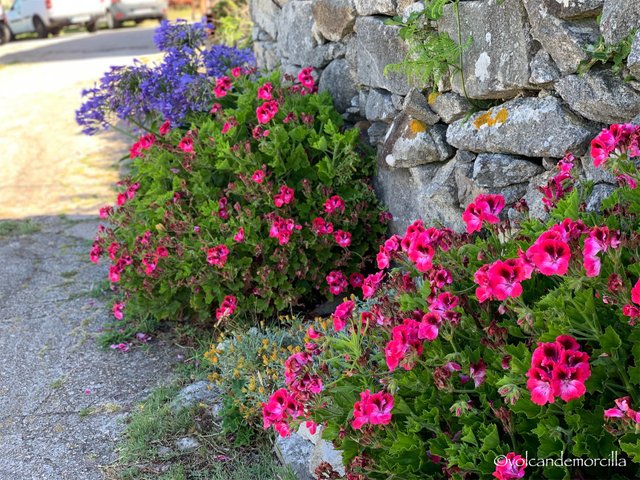
Por esta parte, existía una calzada romana que seguramente enlazaría con la Via XX (Via per loca maritima). Seguramente, por aquí traerían el pescado y el marisco para ser transportado a los grandes puertos de Baiona o Vigo.

El camino, por detrás del monte, es más rápido y corto que el trayecto que pasa por delante del faro y que bordea todo el cabo, siguiendo toda la costa.

El Camino de Santiago siempre ha discurrido por los caminos mas antiguos y, en este caso, no es diferente y ha aprovechado la calzada romana que ha permanecido inalterada desde entonces. Me produce emoción caminar por lugares por los que se ha transitado desde hace miles de años. Me imagino los antiguos peregrinos con sus malas zapatillas caminando por estas piedras llenas del estiércol dejado por los caballos y burros que por aquí avanzarían.
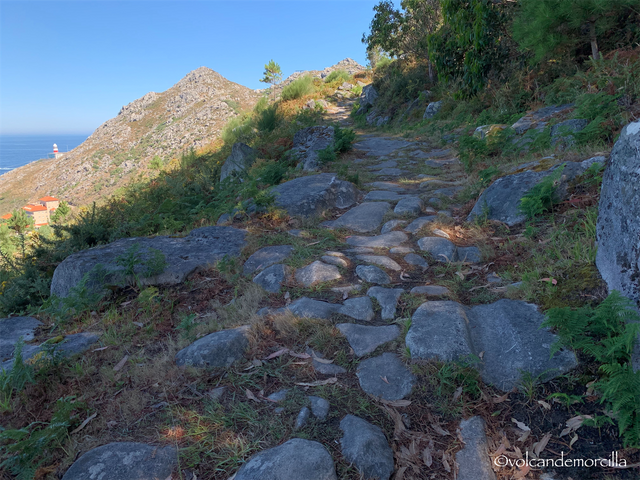
En algunos momentos, los desniveles se me hacen duros. Hay mas de 150 metros de desnivel en un corto espacio y mi forma física no da para mucho. En las pendientes, mi truco es tomármelo con paciencia e ir subiendo poco a poco, a veces incluso haciendo zigzag.
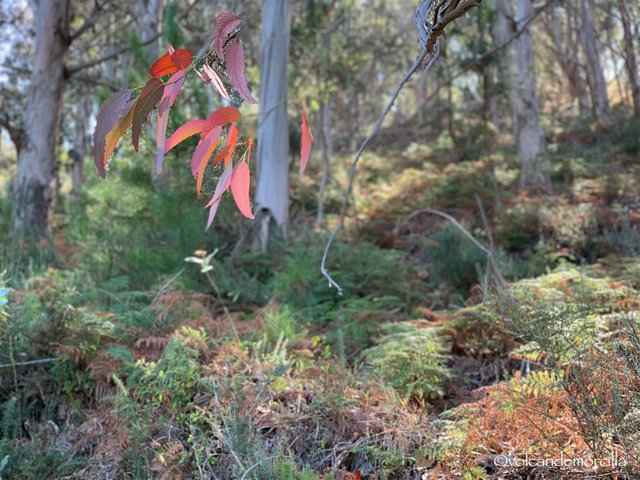
A pesar de la pendiente, el ascenso es abordable. Hace fresco porque el camino se encuentra dentro de un bosque de eucaliptos.
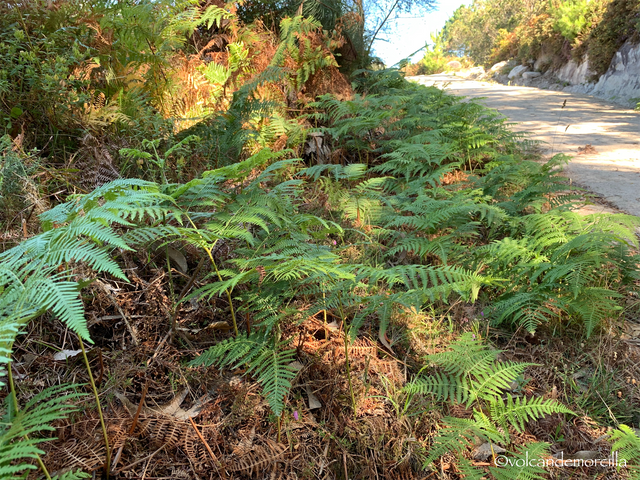
Tengo que parar varias veces y aprovecho para tomar algunas fotos. La fotografía me sirve para recuperar el resuello, disimuladamente.
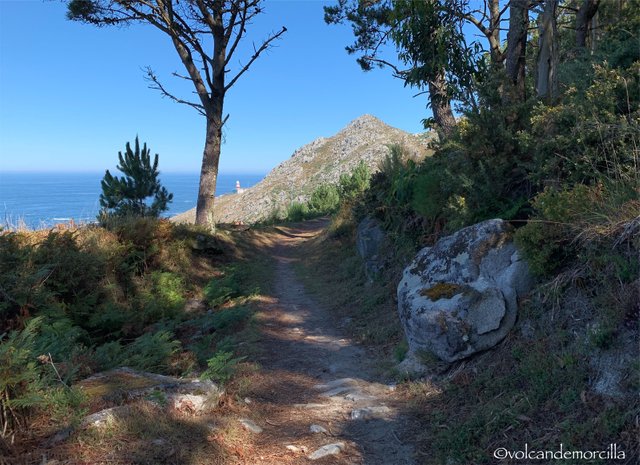
Por ligeros y graduales ascensos, nos elevamos por un camino muy bien preparado. El día está soleado y no hace calor, pero tampoco hace aire. Al mediodía seguramente subirá mucho la temperatura y será desagradable caminar así.

Subimos la montaña y cada vez las vistas son más espectaculares. Desde muchos puntos se divisa el faro de Silleiro que no está en la punta del cabo si no en la falda de la montaña.
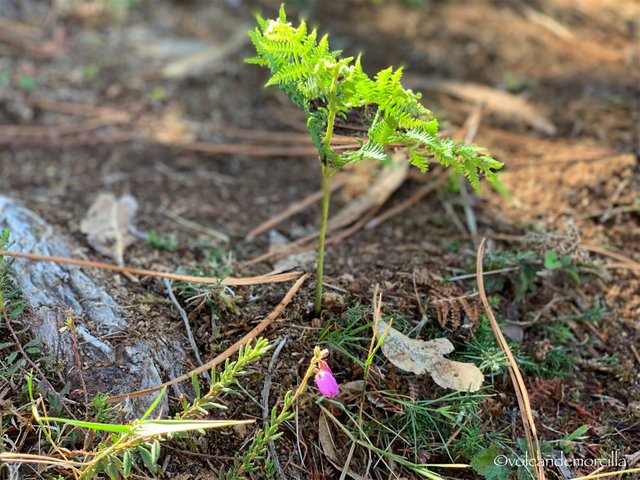
Desde la cima, hay unas magníficas vistas del mar, el faro y la montaña. Luego hay una serie de planicies y mas tarde comenzamos a bajar a Baiona.
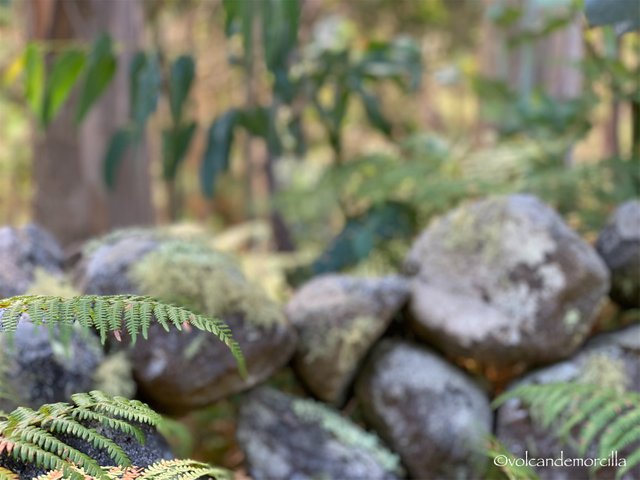
De nuevo por la pista antigua observo que las piedras del camino están arañadas y con hendiduras profundas que han producido el paso, durante cientos de años, de los carros y carreteras.
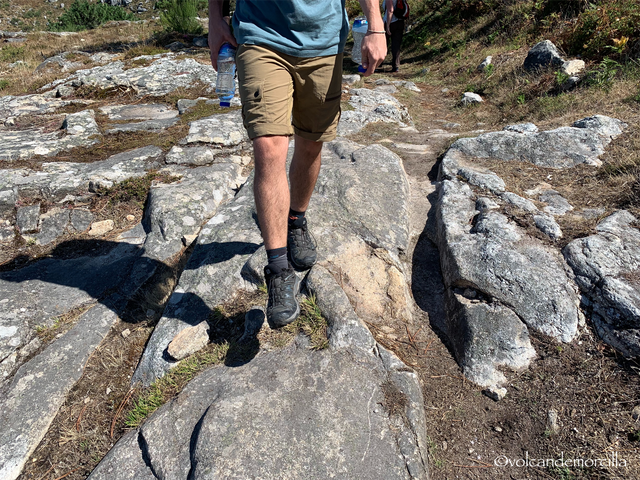
Esta es una antigua vía construida por las legiones romanas hace mas de mil años y que enlazaba con la Via XX, que también era llamada “Via per loca maritima”.
Las ruedas de los carros han erosionado la piedra. El paso constante de carros durante cientos de años ha formado auténticas railes por donde el carretero hacía circular a su caravana.

Camino a Baiona se pasa por zonas donde existen eucaliptos y pinos. Disfrutamos mucho de estos bosques porque en ellos es donde podemos escuchar el canto alegre de los pájaros. También, es muy agradable el aroma húmedo de la tierra y las hojas de los árboles.
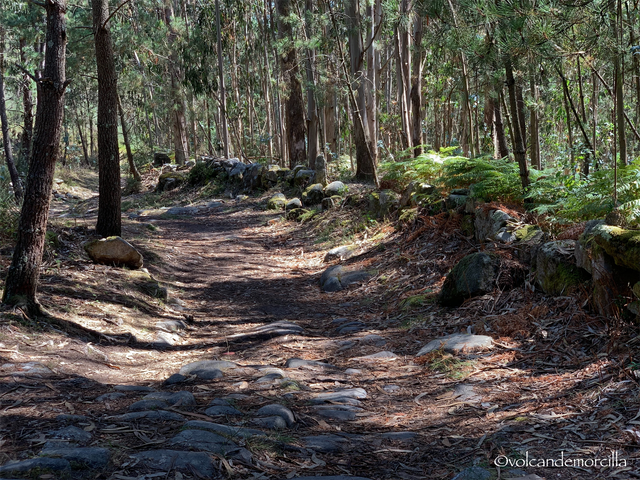
Con frecuencia, se pasa por zonas de helechos que crecen a la sombra de los eucaliptos y de piedras con cubiertas de musgo.

Sin duda, todos convenimos en que esta área boscosa es una de las zonas más bonitas que hasta ahora hemos atravesado.
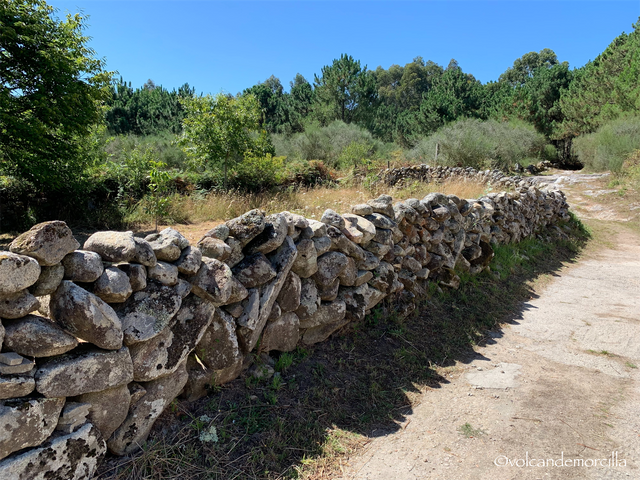
Hacemos un descanso. Es un buen momento, puesto que el sol ya está apretando y los eucaliptos nos proporcionan una buena sombra.
Por toda esta zona hay muchos jabalíes que han crecido de forma salvaje porque alguien los soltó. Esta especie ha conseguido reproducirse de forma natural con mucho éxito. Como no es posible cazar en esta zona, ya que hay muchos senderistas y peregrinos, los jabalíes han ido reproduciéndose a sus anchas. Los lugareños se quejan porque producen en ocasiones grandes destrozos en sus huertas. Con sus hocicos labran la tierra buscando comer las raíces y tubérculos frescos.
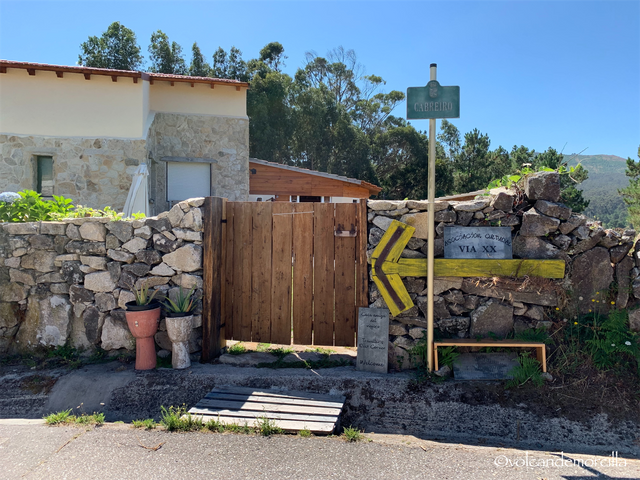
Pasamos por una casa y sus señales nos confirman la sospecha de que esto era una antigua calzada romana.

Este pueblo lo pasamos por entre casas desperdigadas. También vemos un pequeño puente y a su lado un lavadero (lavadoiro) que todavía existen muchos en Galicia.


Al dar una vuelta descubrimos que ya hemos abandonando el litoral del océano Atlántico y estamos ahora entrando en la ría de Vigo. Al fondo se divisan las Islas Cíes.
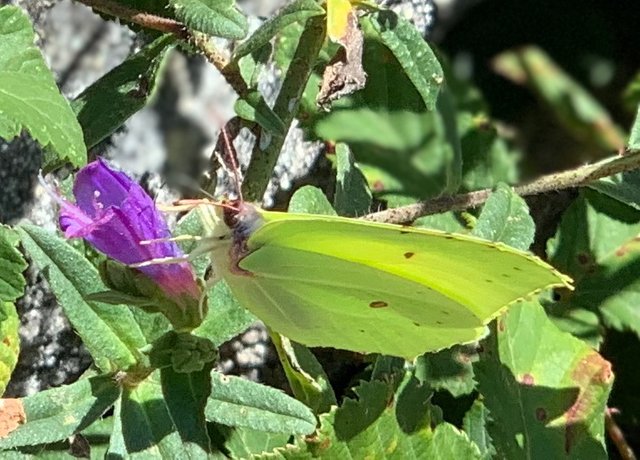
Una mariposa se cruza por delante de mi. La sigo y observo que se posa. Es muy curiosa porque es de color verde. Se camufla con las hojas. Esta posada en una flor violeta. Con cuidado, acerco la cámara y consigo retratarla.


Mas adelante, me entretengo con un caballo blanco que se acerca a saludarme. Tiene cortado el flequillo y varias moscas entorno a los ojos. Me da pena. Se le ve triste.
Tengo que seguir porque, con todo esto, me he quedado muy atrás de los demás.


Pasamos por un torreón muy curioso con una fuente dentro. Por su pequeña puerta me introduzco y me refresco en la fuente. Me viene muy bien encontrarla. Me ha llamado la atención la construcción exterior con lascas de pizarra pero mas me ha sorprendido la inscripción que hay en la fuente. Se trata del yugo y las flechas. Este símbolo, originalmente de los Reyes Católicos, fue utilizado por la Falange española muchos años mas tarde.
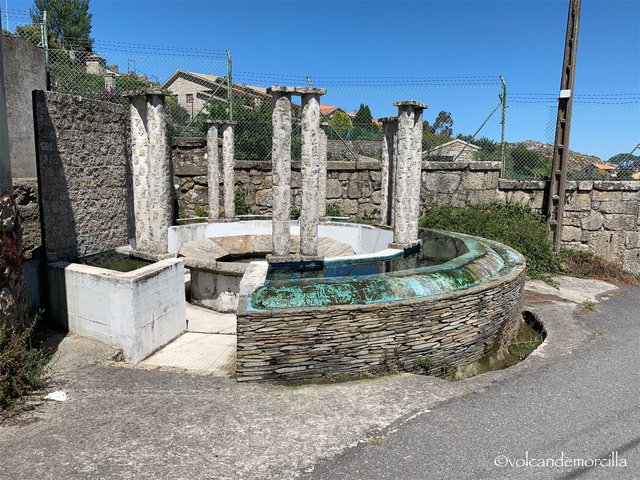
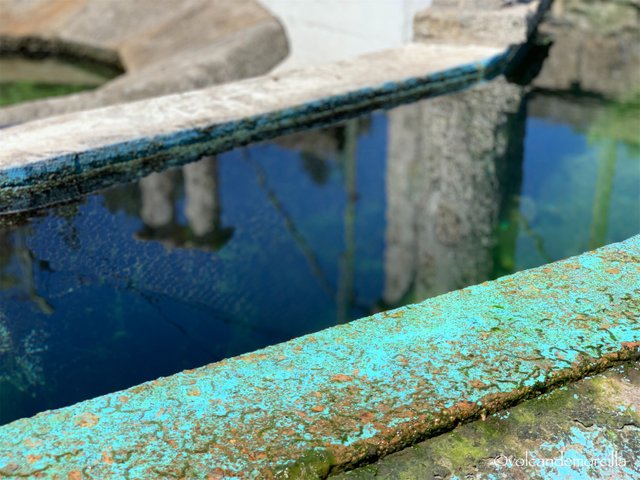
Tras esta estratégica ayuda, pronto encontramos otra fuente de columnas y cobre del mismo diseñador. Es de agradecer esta ayuda que ofrece refresco al peregrino bajo este sol de justicia.

Por fin, entramos en las calles de Baiona. Alfonso IX nos confirma que hemos llegado. Ahora, nuestro objetivo es descansar. No hay nada mejor que descansar cuando se está cansado. Luego... ya veremos.
Bo Camiño!
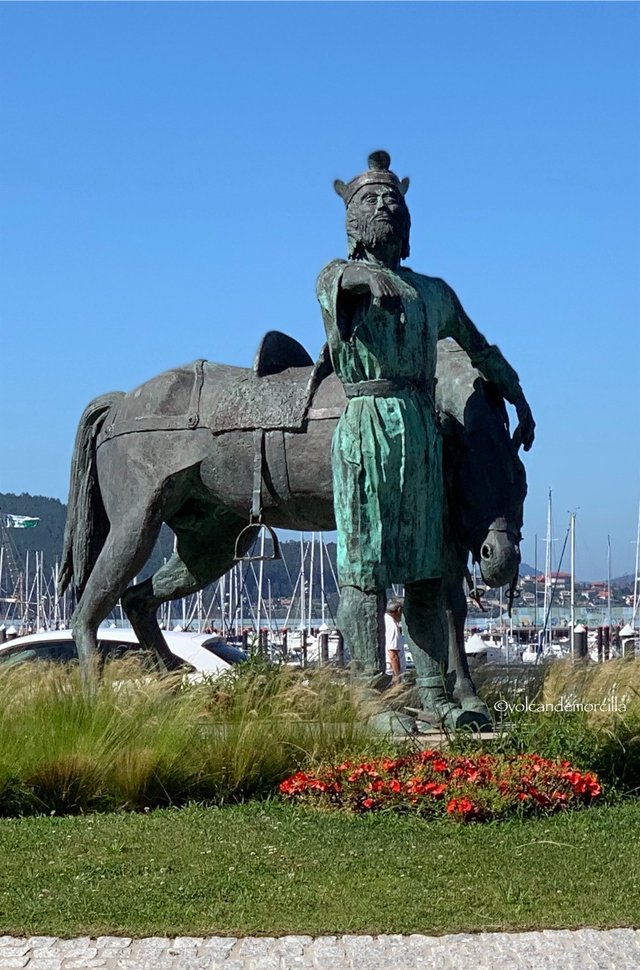
Walking on a Roman road
We start the day with renewed energies. A long stage awaits us today. We start the Camino de Santiago where we leave it, specifically in the Monastery of Oia.
With the coolness of the morning,
The road travels fast. The route goes very close to the coast and runs along tracks. Now, at first, they are very easy to walk.
Sometimes, the road unfortunately runs along the side of the road. Be careful because there are many cyclists who practice this sport.
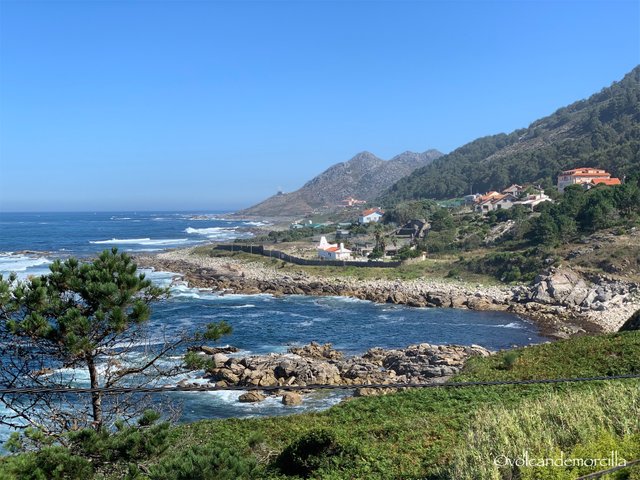
When we approach Baiona, the road separates from the road and enters the forest. In this way the Silleiro lighthouse is avoided.
For this part, there was a Roman road that would surely link with Via XX (Via per loca maritima). Surely, here they would bring the fish and seafood to be transported to the great ports of Baiona or Vigo.
The road, behind the mountain, is faster and shorter than the path that passes in front of the lighthouse and that borders the entire cape, following the entire coast.
The Camino de Santiago has always run along the oldest roads and, in this case, is no different and has taken advantage of the Roman road that has remained unchanged since then. I am excited to walk through places that have been traveled for thousands of years. I imagine the old pilgrims with their bad shoes walking through these stones full of manure left by the horses and donkeys that would advance here.
In some moments, the unevenness is hard for me. There is more than 150 meters of unevenness in a short space and my physical form does not give much. On the slopes, my trick is to take it patiently and go up little by little, sometimes even zigzag.
Despite the slope, the ascent is approachable. It's cool because the road is inside a eucalyptus forest.
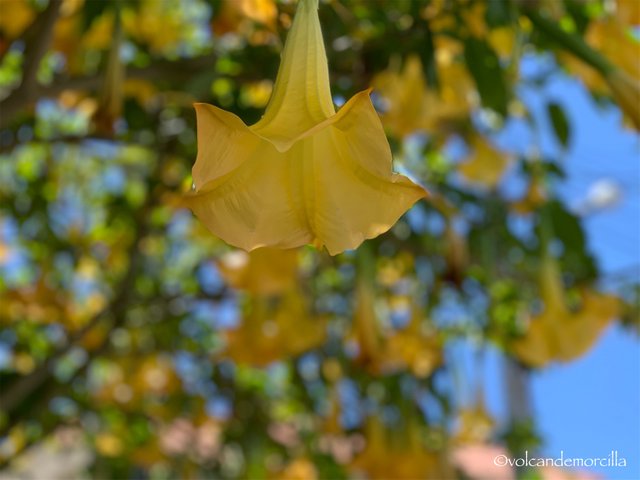
I have to stop several times and take the opportunity to take some photos. Photography helps me to recover my breath, secretly.
By light and gradual ascents we rise along a very well prepared path.
The day is sunny and it is not hot, but neither is it airy. At noon the temperature will surely rise a lot and it will be unpleasant to walk like this.
We climb the mountain and every time the views are more spectacular. From many points you can see the Silleiro lighthouse that is not at the tip of the cape but at the foot of the mountain.
From the top, there are magnificent views of the sea, the lighthouse and the mountain. After reaching the top, there are a series of plains and then start down to Baiona
Again by the old track I observe that the stones of the road are scratched and with deep indentations that have produced the passage, for hundreds of years, of the cars and roads.
This is an old road built by the Roman legions more than a thousand years ago and that linked to the Via that the link must have, perhaps, more than a thousand.
The wheels of the cars have eroded the stone. The constant passage of cars for hundreds of years has formed real rails where the cartman circulated his car.
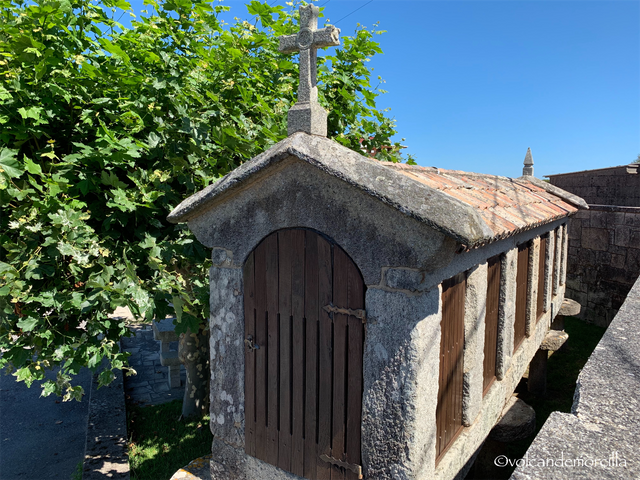
On the way to Baiona you pass through areas where eucalyptus and pine trees exist. Enjoy these forests a lot because it is where we can hear the happy song of the birds. Also, the moist aroma of the earth and the leaves of the trees is very pleasant
Frequently, it passes through areas of ferns that grow in the shade of eucalyptus and moss-covered stones.
Undoubtedly, we all agree that this wooded area is one of the most beautiful areas we have crossed so far.
We take a break. It is a good time, since the sun is already setting and eucalyptus provide us with a good shade.
Throughout this area there are many wild boars that have grown wild because someone released them. This species has managed to reproduce naturally with great success. As it is not possible to hunt in this area since there is a large population of hikers and pilgrims, wild boars have been reproducing freely. The locals complain because they sometimes produce damage to the gardens. With their snouts they work the earth looking to eat the roots and fresh tubers.
We passed through a house and its signs confirm the suspicion that this was an ancient Roman road.
We pass this town through scattered houses. We also see a small bridge and next to it a laundry room (lavairo) that there are still many in Galicia.

When we take a walk, we discover that we have already left the coast of the Atlantic Ocean and are now entering the Vigo estuary. In the background you can see the Cíes Islands.
A butterfly crosses in front of me. I follow her and observe her perch. It is very curious because it is green. It camouflages itself with the leaves. It is perched on a violet flower. Carefully, I approach the camera and manage to portray it.
Later I entertain myself with a white horse that comes to greet me. It has cut the bangs and several flies around the eyes. I feel sorry. He is sad. I have to continue because, with all this, I have fallen far behind others.
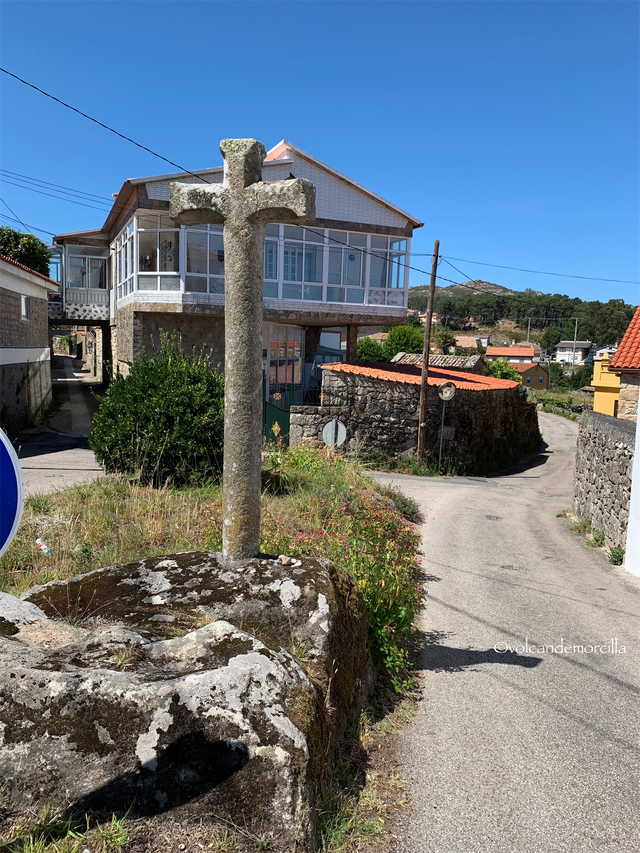
We pass through a very curious tower with a fountain inside. I enter through its small door and refresh myself at the fountain. I find it very good to find her. The exterior construction with slate chips has caught my attention but I was more surprised by the inscription in the fountain. It's about the yoke and the arrows. This symbol, originally from the Catholic Monarchs, was used by the Spanish Phalanx many years later.
After this strategic help, we soon found another source of columns and copper from the same designer. It is appreciated this help offered by the pilgrim soda under this sun of justice.
Finally, we enter the streets of Baiona. Alfonso IX confirms that we have arrived. Now, our goal is to rest. There is nothing better than resting when you are tired. Then ... we'll see.
Bo Camiño!
Bibliografía/Reference 2:Vías Romanas
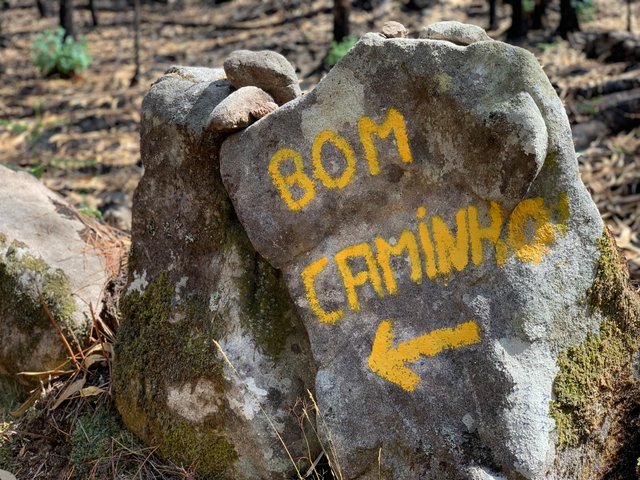
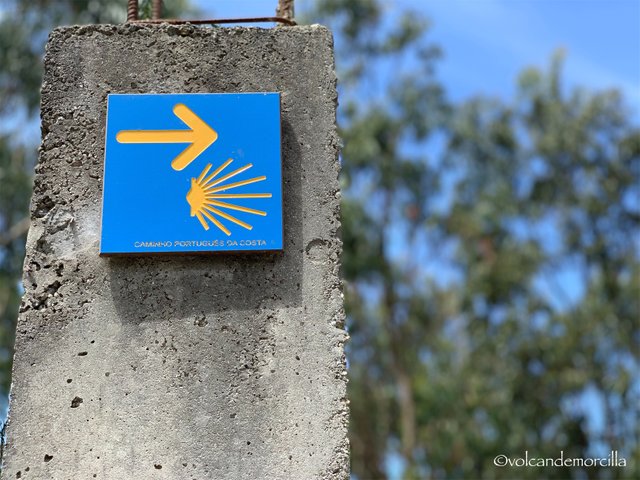

Cómo lo hago
Hice las fotografías con mi iPhone X. Para la edición utilicé la aplicación Snapseed y para la firma digital usé la App Watermark.
Los dibujos los hice en el iPad con el programa Sketches.
For the photography I use my iPhone X. For edition I use the Snapseed application and for the digital signature the Watermark app.
Everything I did on my mobile phone, I did not use the computer at all.
For the drawings, I use the Sketches program and paint them on the tablet.
Si quieres ver como lo hago, visualiza estos tres enlaces de publicaciones previas.
If you want to see how I do it, visualize these three links from previous publications.

Las fotos son mías y originales. También, soy el autor del dibujo separador.
¡Espero tus comentarios!
The photos are originals and mine. Also, I am the author of the separator drawing.
I await your comments.
Buen Camino!
Muchas Gracias amigos 😊
Posted using Partiko iOS
Que interesante! Los romanos construyeron la primera red the calles y caminos y fue muy importante para su control como imperio.
Bueno antes que los romanos hubo una red de calzadas muy importante que construyeron los griegos y mucho más importante que los griegos fueron persas que llegaron a tener una calzada de 1700 km de larga. Los romanos, eso sí, expandieron esa tela de araña de manera muy importante. Un saludo 😊
Posted using Partiko iOS
Tienen mucha fortaleza y la axtitud, también es importante. Me encantó este recorrido, describes muy bien la dificultad para transitar por esos caminos aunque valió la pena por ese maravilloso paisaje y obviamente, tu objetivo. Continuen el buen camino. Saludos.
Gracias por tus ánimos. Seguimos adelante con optimismo y disfrutando de tanta naturaleza y paisaje rural. Avanzamos juntos!!😊
Posted using Partiko iOS
Tengo que decir que me gustan los paisajes, tienen una frescura perfecta! Y por segundo, muy buenas fotos! Saludos =D
Muchas Gracias, aprecio mucho tus palabras, viendo de un profesional de la fotografía. Me da ánimos y enorgullece. Gracias 😊
Posted using Partiko iOS
Hola amigo. Me imagino tener puesta las sandalias de antes y caminar por ese empedrado ¡Pobres pies!. El caballo es lindo ¿Será viejo? Los caballos viejos tenemos la mirada triste generalmente ja,ja,ja.
Curiosamente cada 20 km había un lugar donde parar y descansar que reunía una buena calidad de alojamiento porque en ellos descansaban los “jefes”. Los repartían cada 20 km más o menos, que son las distancias que actualmente tenemos entre nuestros pueblos. No debía ser tan bonito recorrer esto. Yo me lo imagino lleno de basura. 😊
Posted using Partiko iOS
Vaya un viaje espiritual y natural el que has emprendido, fantástico, debe ser increíble andar por esos caminos por los que como afirmas ha caminado gente de otras épocas, vamos contigo en el trayecto a través de tus imágenes, de tu mirada, abrazos.
La verdad es que sentí una emoción especial imaginándome todo aquello lleno de estiércol y de caminantes unos tras otros. Cómo sería aquello? Me llamó la atención que las pendientes eran muy pronunciadas. No sé cómo podrían hacer con los caballos para subir o bajar. Un abrazo 🤗
Posted using Partiko iOS
Nos presentas siempre unas publicaciones asombrosas pero este paseo por las imágenes era realmente admirable...
Abrazos @volcandemorcilla!!!
Muchas gracias @avellana. A veces me planteo si no miro las cosas con ojos de niño 👦. Gracias por leerme.
Posted using Partiko iOS
Votado por el trail @team-mexico
Servidor en Discord TeamMexicoPRO ¡Te esperamos!
Delegaciones para @team-mexico ¡Ayúdanos a crecer!
10 SP - 25 SP - 50 SP - 100 SP - 150 SP- Mas información.
.png)
Muchas Gracias amigos 😊
Posted using Partiko iOS
En esta ocasión me ha cautivado la mariposa con su camuflaje perfecto.
Se cruzó por delante y se paró a un lado camuflada. Nunca había visto una así..
Posted using Partiko iOS
Oh wow what a wonderful walk through this beautiful and ancient place!
To think of how many walked there before, built to last! :-)
I like the little sun looking symbol painted on the rock. I'm a big
fan of rocks and love all the photographs you have here!
What a fantastic trip and posting @volcandemorcilla!
Hello friend, I am on the Santiago Way, which is a pilgrimage route that is more than 1000 years old. That's why I go through these ancient places. If you like the publication, you might like the ones I made earlier and the ones I've done before. Thank you very much for your appreciation. 😊
Posted using Partiko iOS